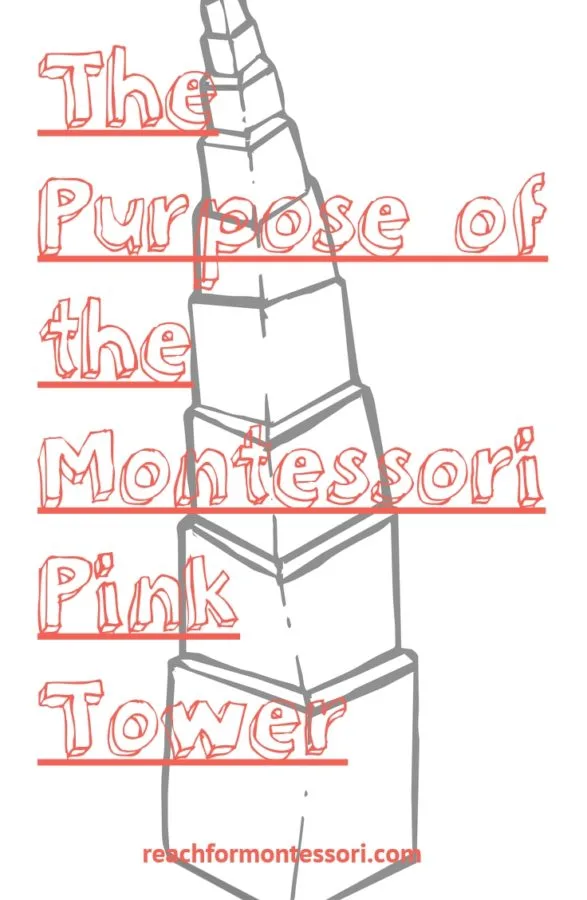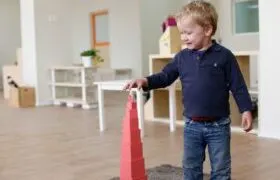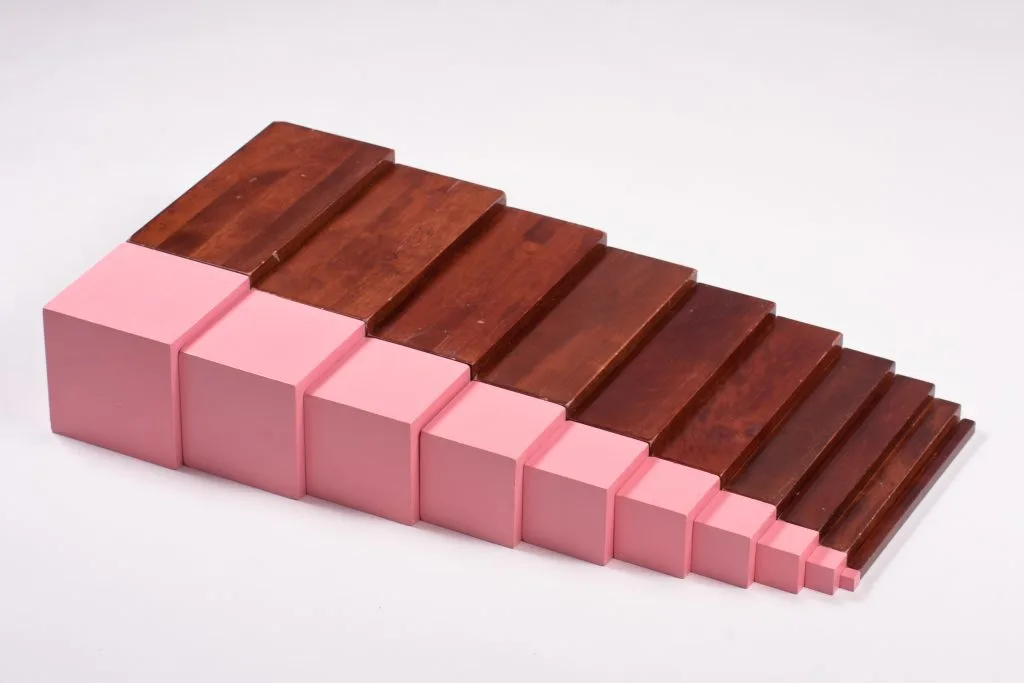Whether you're curious about what the Montessori Pink Tower is or you've purchased the Pink Tower and you now want to know how to present it, you've come to the right place.
Here, I'm going to tell you what you need to know about the Pink Tower, including its purpose and how to give the Pink Tower Lesson.
This is one of the first materials I purchased for my children after obtaining my Montessori certification, so it holds a special place in my heart.
So, let's get right into it.

(This post contains affiliate links. Purchasing from these links costs you nothing extra, but sends a few cents our way for website upkeep.)
What is the Montessori Pink Tower
The Pink Tower is one of the first sensory materials your child might work with in their Montessori primary program.
It's a set of 10 wooden cubes that increase in size by one cubic centimeter per block.
The largest wooden cube is 10cm on each side and the smallest cube is 1cm on each side, if that's a better way to explain it.
The cubes are one color, which isolates the concept of size for children.
This is a grading activity wherein the cubes are supposed to be placed one on top of the other based on their size.
Isolating concepts is a common theme in Montessori classrooms, and Montessori-familiar parents often look for this quality in the toys and activities they keep in their homes.

Isolating the concept of size, in the case of the Pink Tower, helps children focus on discriminating the varying dimensions without the distraction and added confusion of different colors.
What is the purpose of the Pink Tower in Montessori?
This seemingly simple Montessori activity is pretty in-depth in its purpose.
The Pink Tower helps children develop visual discrimination, introduces them to mathematical concepts, and helps to develop their fine motor skills.
The visual discrimination of the following dimensions is the focus of constructing the Pink Tower:
- length
- width
- height
In addition to these points, weight and its relation to the size of each block is something that can be discussed when building the Pink Tower.
The cubes are meant to be carried individually to a child's workspace.
This is in part, so they can get a better sense of the size and weight of each cube.
This material is designed to help children gain a sense of sequence. It also serves as an introduction to the decimal system.
An even more interesting feature of this seemingly simple Montessori material is that it is pre-algebra work.
While this isn't something that is discussed with a 3-year-old, handling and stacking the pink cubes and working with the activity extensions are introducing a child to the concepts of volume and the third power (cubing).

The control of error for the activity, much like that of the Long Red Rods, is the child's own observation.
During the time this material is introduced to a child, they are in the period of the absorbent mind.
It's important when watching a child build the Tower, not to interrupt or correct them.
Let them see for themselves that the Tower they've built doesn't quite look like it looked when it was constructed before they brought it over to their workspace.
The error(s) they made are likely to pop out at them.
If they don't notice their error, that is perfectly ok.
When it's time to return the cubes to their place in the room, they are shown how to return the cubes, one at a time, starting with the largest cube.
This will reinforce the correct order of the cubes and they are likely to have more success on their next attempt.
Another purpose of the Montessori Pink Tower is the language introduced during the activity. “Large, larger, largest”, and “small, smaller, smallest”…language used when grading objects.
So, you see there is more to the Montessori Pink Tower than a simple building activity. Its purpose builds on skills children will use far beyond the primary years.
How to present the Montessori Pink Tower
When you take the Pink Tower to the child's work mat or work area on the floor, you'll be doing it one cube at a time, starting with the smallest cube on the top of the tower.
The large cubes at the bottom should be carried with one hand carrying and the other hand over the top of the cube.
The cubes should be placed in random order on the mat.
- Take the largest cube with both hands, one on each side, and move it slowly over the other cubes for comparison then place it in front of the child.
- Pick up the next largest pink cube, compare it to the other cubes, and then place it carefully in the center of the first cube.
- Repeat this with all of the remaining cubes.
- Walk around the tower with the child and observe it from various angles.
- Dismantle the tower and invite the child to rebuild it.
After you give the Pink Tower presentation, you can do three-period lessons and extensions.
Pink Tower lesson extensions include :
- Stereognostic (blindfolded) activity – Have the child build the Pink Tower while blindfolded.
- Build the tower horizontally.
- Build the tower with one cube removed and ask the child if they can locate on the finished tower where the cube belongs.
Cheers and don't forget to subscribe!
